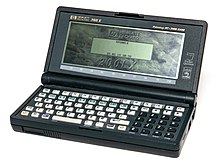| This article needs additional citations for verification. Please help improve this article by adding citations to reliable sources. Unsourced material may be challenged and removed. Find sources: "Palmtop PC" – news · newspapers · books · scholar · JSTOR (November 2024) (Learn how and when to remove this message) |

A Palmtop PC is an obsolete, approximately pocket calculator-sized, battery-powered computer in a horizontal clamshell design with integrated keyboard and display. It could be used like a modern subnotebook, but was light enough to be comfortably used handheld as well. Most Palmtop PCs were small enough to be stored in a user's shirt or jacket pockets.
Palmtop PCs distinguish from other palmtop computers by using a mostly IBM-compatible PC architecture, and BIOS as well as an Intel-compatible x86 processor. All such devices were DOS-based, with DOS stored in ROM. While many Palmtop PCs came with a number of PDA and office applications pre-installed in ROM, most of them could also run generic, off-the-shelf PC software with no or little modifications. Some could also run other operating systems such as GEOS, Windows 1.0-3.0 (in Real mode only), or MINIX 2.0.
Most Palmtop PCs have been based on a static hardware design for low power consumption, and instant-on/off without the need to reboot. Depending on the model, the battery could power the device for a period ranging from several hours up to several days while running, or between a week and a year in standby mode. Combined with the instant-on/off feature, a battery would typically last from a week up to several months in practical use as PDA.
The first Palmtop PC was the DIP Pocket PC (aka Atari Portfolio) in 1989.
Palmtop PCs include:
- DIP Pocket PC (DIP DOS 2.11, 1989)
- Atari Portfolio (DIP DOS 2.11, 1989)
- Poqet PC Classic (MS-DOS 3.3, 80C88, 1989)
- Poqet PC Prime (MS-DOS 3.3, 80C88)
- Poqet PC Plus (MS-DOS 5.0, NEC V30)
- ZEOS Pocket PC (MS-DOS 5.0, 1991)
- Sharp PC-3000 (MS-DOS 3.3, 1991)
- Sharp PC-3100 (MS-DOS 3.3, 1991)
- Hewlett-Packard 95LX (MS-DOS 3.22, NEC V20, 1991)
- Hewlett-Packard 100LX (MS-DOS 5.0, 80186-compatible HP Hornet, 1993)
- Hewlett-Packard Palmtop FX (MS-DOS 5.0, 80186-compatible HP Hornet, 1993)
- Hewlett-Packard 200LX (MS-DOS 5.0, 80186-compatible HP Hornet, 1994)
- Hewlett-Packard 1000CX (MS-DOS 5.0, 80186-compatible HP Hornet)
- Hewlett-Packard OmniGo 700LX (MS-DOS 5.0, 80186-compatible HP Hornet, 1996)
Some touch-screen computers may also be included in this category:
- Hewlett-Packard OmniGo 100 (Datalight ROM-DOS+PEN/GEOS 2.1, NEC V30HL-compatible Vadem VG230, 1993)
- Hewlett-Packard OmniGo 120 (DOS+PEN/GEOS, NEC V30HL-compatible Vadem VG230)
See also
- Sub-notebook, not necessarily IBM- and x86- compatible, clamshell design, but larger than Palmtop PCs
- Handheld PC, not necessarily IBM- and x86- compatible, various form factors
- Netbook (generic), IBM- and x86- compatible, legacy-free, clamshell design
- Ultra-mobile PC, a Microsoft specification (IBM- and x86- compatible, legacy-free, not necessarily clamshell design, touchscreen)
- netBook, StrongARM, clamshell design, touchscreen
- Pocket PC, a Microsoft specification (ARM-based, various form factors, touchscreen)
- PalmDOS
- Electronic organizer
- PDA (Personal Digital Assistant)
References
- Smith, Tony (7 June 2007). "Atari's Portfolio: the world's first palmtop". The A Register. Retrieved 30 November 2024.
| Computer sizes and classes | |||||||||||||||||||||||
|---|---|---|---|---|---|---|---|---|---|---|---|---|---|---|---|---|---|---|---|---|---|---|---|
| Micro |
| ||||||||||||||||||||||
| Midrange | |||||||||||||||||||||||
| Large | |||||||||||||||||||||||
| Others | |||||||||||||||||||||||
This computing article is a stub. You can help Misplaced Pages by expanding it. |